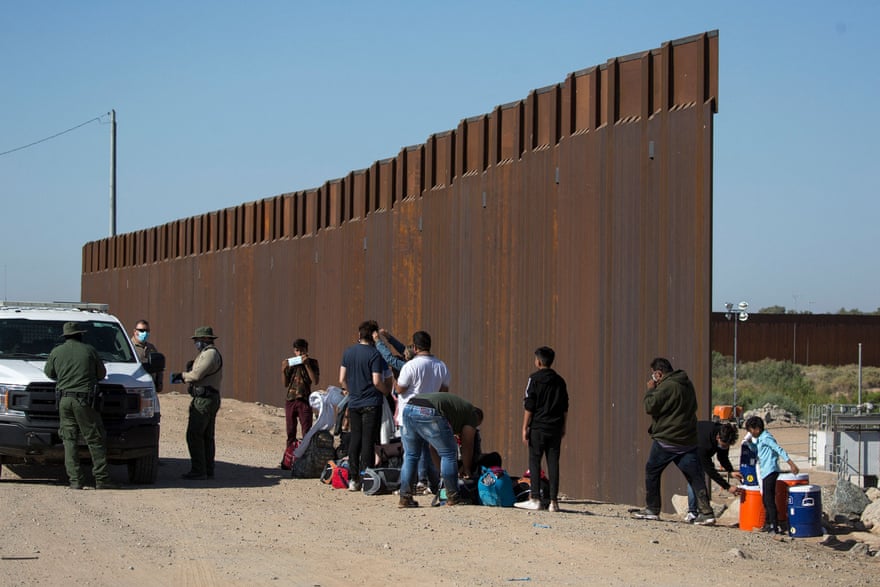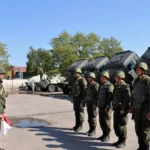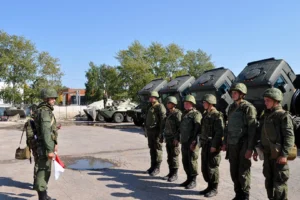Title 42 bans all migrants from entering the country over spread of Covid – but the rule is largely enforced against Mexicans and people from Guatemala, Honduras and El Salvador
As hundreds of migrants line up along an Arizona border barrier around 4am, agents try to separate them into groups by nationality.
“Anyone from Russia or Bangladesh? I need somebody else from Russia here,” an agent shouts and then says quietly, almost to himself: “These are Romanian.”
It’s a routine early morning task for Customs and Border Protection (CBP) in this flat expanse of desert where the wall ends. People from at least 115 countries have been stopped here during the past year, with entire families from Venezuela, Colombia, Haiti, Cuba, Brazil, India, the Cameroon among those arriving in Yuma, south-west Arizona after wading through the perilous knee-deep Colorado River.
It marks a dramatic shift away from the recent past, when migrants were predominantly from Mexico and Central America’s Northern Triangle countries – Guatemala, Honduras and El Salvador, escaping a mix of state sponsored and criminal violence, corruption and extreme poverty.
People not from Mexico and the Northern Triangle accounted for 41% of detentions on the border from October 2021 to July 2022 – up from only 12% three years earlier, according to official figures. Meanwhile, Mexicans made up 35% of all border encounters – higher than three years ago but well below the 85% reported in 2011 and the 95% at the turn of the century.
The changing demographics reflects how a controversial pandemic-era rule still shapes the fate of some migrants, even though much of the US has moved on from Covid.
The impact of Title 42, a Trump era mandate barring migrants and asylum seekers from entering the country at land borders, is especially stark at some of the busiest crossings such as Yuma in south-western Arizona and Eagle Pass, Texas, close to where at least nine people died last week while trying to cross the rain-swollen river.
The only option for most Mexicans and Central Americans caught up in the Title 42 ban is to try crossing at more isolated and less militarized points in hope of eluding detention – otherwise they are likely to be summarily expelled, and refused the opportunity to seek asylum.
Mexicans still account for seven of every 10 encounters in the Tucson area in southern Arizona, where John Modlin, the CBP sector chief, said smugglers order them to walk at night with black-painted water jugs, camouflage backpacks and boots with carpeted soles to avoid leaving tracks in the sand.

“Incredibly different tale of two borders, even though they’re within the same state,” said Modlin.
In Yuma, migrants from Asia, Africa, South America and the Middle East arrive having typically walked a short distance through tribal lands, and surrender to border patrol agents. They come wearing sandals and carrying shopping bags stuffed with belongings over their shoulders, expecting to be released to pursue their immigration cases. Some carry toddlers on their hips.
On paper, Title 42 denies people of all nationalities the right to seek asylum on grounds of preventing the spread of Covid . In reality, the rule has been largely selectively enforced against Mexicans and people from Guatemala, Honduras and El Salvador, who the Mexican government agreed to accept.
Most other nationalities have been spared due to the US not wanting to pay for expensive flights and limited diplomatic options.
“The challenge is what Mexico can accept,” Modlin said. “That’s always going to be a limiting factor.”
So far, the Biden administration’s attempts to wind down Title 42 have been blocked by the courts. Yet it’s continuing use depends on where people come from and which port of entry they are trying to seek asylum. In Yuma, Title 42 was applied in less than 1% of of 24,424 stops in July –.Whereas in Tucson, it was used in 71% of detentions.
It is unclear why.
“What we know with absolute certainty is that the smuggling organizations control the flow,” Modlin said. “They decide who goes where and when they go to the point. It’s almost like air traffic control of moving people around.”
In Yuma, groups of up to two dozen or so migrants dropped off by bus or car on a deserted Mexican highway begin arriving in the US shortly after midnight.
If English and Spanish fail, agents use Google Translate to question them, under generator-powered lights, take photos and load them onto buses.
One recent morning, six Russians said they flew from Istanbul to Tijuana, Mexico, with a stop in Cancun, and hired a driver to take them four hours to the deserted highway where they crossed.
A 26-year-old man who’d flown from his home in Peru to Tijuana said the most difficult part of the journey was the anxiety about whether he’d make it to his destination in New Jersey.
Nelson Munera, 40, said he, his wife and their 17-year-old son got off a bus on the highway and crossed to Yuma because fellow Colombians had taken the same route.
Lazaro Lopez, 48, who came with his nine-year-old son from Cuba by flying to Nicaragua and crossing Mexico over land, chose Yuma because that’s where his smuggler guided him.
Most will be released on humanitarian parole or with a notice to appear in immigration court.
From here, the border patrol drops off hundreds of migrants each day at the Regional Center for Border Health near Yuma, that charters six buses daily to transport them almost 200 miles north-east to Phoenix Sky Harbor international airport.
“We have seen families from over 140 countries,” said Amanda Aguirre, the clinic’s chief executive officer. “We haven’t seen one from Mexico, not through our processing.”
The shift is also evident on the Mexican side of the border.
The Don Chon migrant shelter in nearby San Luis Rio Colorado fills many of its roughly 50 beds with Central Americans expelled under Title 42.
Kelvin Zambrano, 33, who arrived in a large group of Hondurans, said he fled threats of extortion and gang violence, but border agents were not interested in hearing his story. “I don’t know why, but they don’t want Hondurans,” he said.
Source : The Guardian












